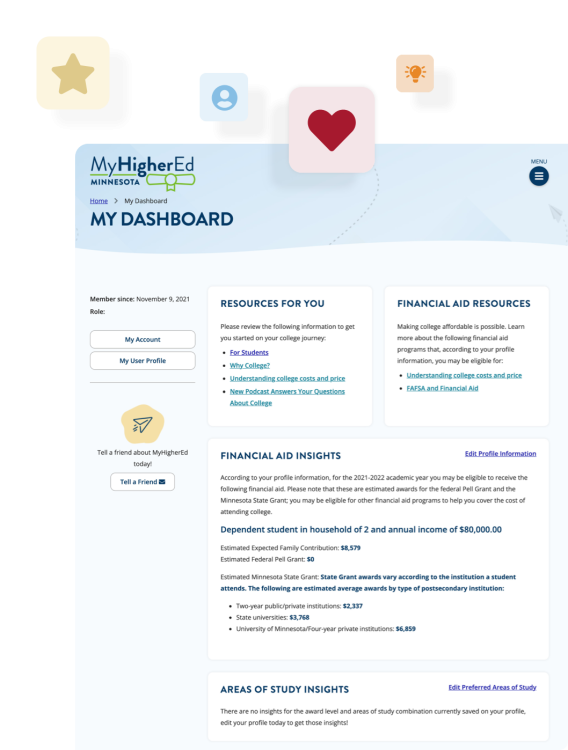You have decided to transfer schools. Now is time to move quickly and start taking actions toward a successful transfer. Your first priority should be making sure your prospective school will match your expectations: visit the campus, talk to students, and fully understand their transfer policies.
Research Is Key
Maybe your current program isn’t the right fit, or you have personal reasons to change institutions. Perhaps you completed general requirements at one college -or left without completing- and would like to complete at a different one. The important task you now face is transferring schools as smoothly as possible, and without incurring unnecessary expenses. The following list will keep you organized to make sure your transfer help you achieve your goals:
MyHigherEd Newsletter
Get the latest financial aid tips and related news sent directly to your inbox.
Determine what you want from your new program and start searching for schools
Think of the educational experience you want at your new institution. Features like academic rigor, setting and campus environment, support services, net price and affordability may be important for you.
Contact the admissions office
Once you have selected an institution to transfer to, you must learn how to transfer your credits from your current or previous school to the new college and make them count toward your major or credential. Review the policies regarding course equivalency, transfers between course levels, and transfers between quarter and semester systems.
You should directly request information from an admissions advisor to make sure you understand their policies and assess the transferability of your credits.
If you're considering a few prospective institutions, you should reach out to all of them. Admissions advisor will help understand the institution’s transfer policies to select the best option.
Contact an academic advisor at your current college to maximize your credit transferability
If you have decided to transfer institutions, discuss with an advisor your options for making the transfer possible. They can also provide suggestions and clear pathways available to you.
Additionally, your academic advisor should be able to help you through the process of transferring college credits by providing you with the correct forms, helping you request transcripts, and detailing any transfer agreements the college holds with other institutions. This process may simplify your path ahead by narrowing down your choices.
Learn about accreditation requirements and transfer/articulation agreements
Transfer and articulation agreements between institutions make it easier for students to transfer all or most of their credits to their new program. It is advisable to review and compare how many credits you could transfer depending on the institutions you are considering. Each credit you fail to transfer, translates to extended time and money that you will have to invest in your new program.
Contact the financial aid offer at prospective institutions
Even though students who receive aid through the FAFSA typically receive similar federal funding at their new college, they lose individual scholarships granted at their previous institutions. Reach out to the financial aid advisor to help you calculate your student aid qualifications -based on your FAFSA results- and advise on what your financial aid package amount to.
If you were counting on student loans to help you pay for college at your previous institution, you should reach out to your lender to learn about your options. Some loans may not transfer between colleges.
Make sure you review application deadlines
Also review other required paperwork to submit with your application. The application process for a transfer student is likely different from the application process for a first-time undergraduate college student, as it usually focuses on your previous college coursework and academic performance. You should start compiling all paperwork needed for transferring between colleges as soon as possible.
Request transcripts from all previously attended colleges or institutions
Verify whether a prospective school requires official or unofficial transcripts. Also, you should gather letters of recommendation to submit along with your application.
Reach out again to admissions advisors at your prospective schools to show them your unofficial transcripts and get information on what credits can transfer. Confirm transferable credits with the major department and the admissions office at each college you are considering.
Compare each institution to make the best choice
Analyze the pros and cons for transferring at each college to find the program and institution that best aligns with your educational and career goal. Understand what setbacks, if any, you may encounter by transferring and how much this could cost you in in time and money. Transferring colleges may also involve extra fees.
Start the application process at the institution you selected
Submit the application and appropriate supporting paperwork. Additionally, submit your unofficial or official transcripts from previously attended colleges. You may also be requested to submit your resume, letters of recommendation, and essays.
Once you submitted your application, look for financial aid opportunities. Contact the financial aid office at your new institution to make sure they can provide you with a financial aid package. You should also check in with the admissions office to ensure they received your transcripts and you are aware of their decision timeline.




